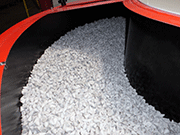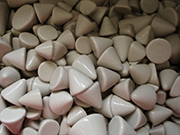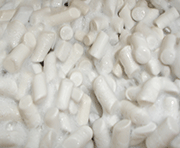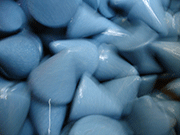E-Archive
Articles
in Vol. 17 - September Issue - Year 2016
The New Media Generation





Selection of porcelain, plastic and QF media according to the Rollwasch production programme
Nowadays, the media are in constant evolution not only to find new solutions to satisfy any kind of process but also with an extreme attention to the environmental point of view.
The environment aspect must be considered, in fact, both sides: by production point of view, to manufacture the media reducing CO2 and other similar pollutants and using renewable energy sources; by user point of view, to reduce waste volumes, or have recycling options, maintaining at the same time good performances or even better.
Before the 60's, the production tools were quite simple, as at the time, mass metal finishing was based on turning barrels and river stones. Later on, between the 60's and the 70's, a strong investment in the mass metal finishing field was made to find or to improve new lines of products like ceramic and plastic media.
As far as the plastic media are concerned, the range has become always wider and with specific geometrical shapes and sizes, depending from the workpieces to be treated and also the removal rates required in many different types of finishing process and applications. Starting from the year 2000, the polyester-bonded media were subjected to a revision of the formula with the common target to reduce the foam. Also, the "amminoplastic" bonded media has been improved starting from the year 2002, as the "long life" version of the most common "urea formaldehyde" bonded media, the complete production process of this kind of media and the basic formulation has been revised with real and remarkable improvements of its performances.
As far as the ceramic media is concerned, this series of abrasive media stand out for a wide range of different formulations and includes several different qualities of mixtures that can be sum up as abrasion degree, quality, power and for its density.
Ceramic media have improved with the main target to reduce, as much as possible, the "chipping" factor (but there are some physical limits that do not allow the reduction to "zero"), being the ceramic media that is very hard and easy to produce, when brand new, small chippings and fragments may occur.
Part of this problem is reduced providing a preliminary use of the media, called conditioning.
A similar aspect is related to the porcelain media, which surface skin at the origin is not as fine and shiny as after some hours of work and, many times, it is required to be reconditioned before use.
In the following years, also other media were applied to finishing processes, not only ceramic, porcelain and plastic, but also vegetable granulates like ground corncob, glass balls and micro balls, cupper and stainless steel pins and special shaped micro media (for the watch industry), casted iron pyramids (for laser cut and oxy-cut deburring in special barrels), stainless steel balls for ball burnishing mainly, together with a big variety of chemical compounds specifically studied for the finishing processes.
Starting from 2010, a completely new range of media has been produced and called QF (acronym of: Quattrofinish®, with the aim to substitute four kind of media, respectively polyester, amminoplastic, ceramic and porcelain media), providing innovative finishing solutions, such as the Microfluid (wet process with very low use of water), Vibrodry and Rotodry dry finishing processes, which are environmentally friendly and designed to reduce the cost of finishing, water treatment and waste volumes, thanks to their very long life (about 10 to 20 times longer life respectively to common plastic and ceramic media).
Quattrofinish® (patent pending - I) is a series of abrasive media of the third generation that offers favourable performances from different points of view. The Quattrofinish® media are obtained through innovative injection moulding techniques that allow reaching of first-rate geometrical and dimensional precision. The raw materials used in the production usually include four elements, whose combination allows emulating the features of a plastic, ceramic or porcelain media without in any way showing the shrinking typical problems of the ceramic material baking. Abrasion, weight (density), grip, and finishing action on the metal express the required features. The table of the features gives a very good and useful support to identify the most suitable media for the required finishing.
It is difficult to compare the life of these new Quattrofinish® media to the plastic chips of the old generation or to the most widespread ceramic media as, under the same performances, these new media last much, much longer. A pleasant surprise comes from the waste water treatment (in case of the wet finishing process or even Microfluid cycles), where the volume of mud, the treatment costs and the maintenance operations (cleaning of the filtering cloths, filter, etc.) are drastically reduced. A last, but not less important aspect, is the possibility to recycle the media that are eliminated because of being too small.
Almost all the media solution together with the new chemical compounds and the new generation of machines open new working process scenarios, like Microfluid, Vibrodry, or Rotodry as above described, with additional benefits to the ones offered by the media themselves.
Rollwasch, with its laboratories and skillful technicians and engineers, is always available to analyze new potentials and evaluate the pertinence of the innovative technologies to each customer's need.
For Information:
Rollwasch® Italiana S.p.a.
Via San Carlo, 21
20847 Albiate (MB), Italia
Tel. +39.0362.930334
Fax +39.0362.931440
E-mail: info@rollwasch.it
www.rollwasch.it



























